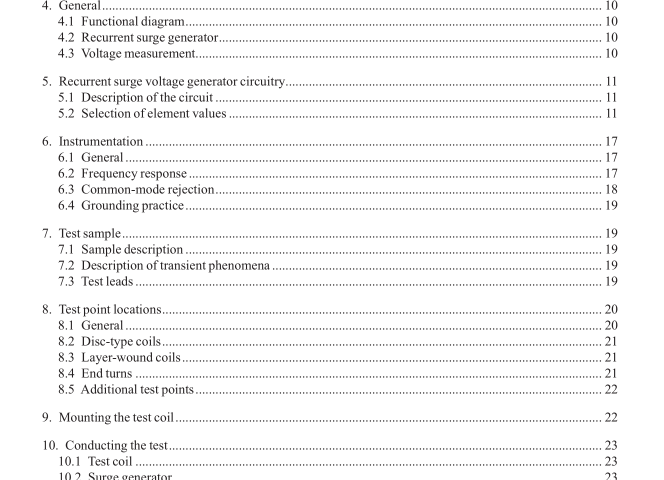IEEE C57.12.58-2017 pdf download.IEEE Guide for Conducting a Transient Voltage Analysis of a Dry-Type Transformer Coil
3. Defnitions For the purposes of this document, the following terms and defnitions apply. The IEEE Standards Dictionary Online should be consulted for terms not defned in this clause. 4 Standard transformer terminology, which is available in IEEE Std C57.12.80™, shall apply. 5 basic lightning impulse insulation level (BIL): A specifc insulation level expressed in kilovolts of the crest value of a standard lightning impulse.
4. General
4.1 Functional diagram Because the function of transient analysis is to determine the response of various parts of the coil to an impulse wave, the circuitry and instrumentation shall be designed with that goal in mind. From a functional point of view, the relationship between the test specimen, circuitry, and instrumentation may be seen best in the form of a block diagram, as shown in Figure 1.
4.2 Recurrent surge generator
The voltage-generation and wave-shaping functions are performed by a device called a recurrent surge generator. This generator shall duplicate and repeat, at some voltage compatible with low-voltage instrumentation, the wave shapes seen at the output of an impulse generator. The surge generator, since it is operating at a low voltage, may generate the wave on a recurrent basis. In fact, observation of voltages on an oscilloscope face will be facilitated if the voltage wave is recurrent.
4.3 Voltage measurement
The voltage is applied across the test coil at the line terminals. Voltages between various points within the coil are measured with a high-frequency oscilloscope or other device using a diferential amplifer and probes at the input. It is highly desirable that there be synchronization between the generator and the recording instrumentation. This may be accomplished by either a delay in the signal or triggering in advance of the wave. This ensures the establishment of a zero reference point at the readout. Digital equipment may ofer other synchronization methods.
5. Recurrent surge voltage generator circuitry
5.1 Description of the circuit
The circuitry is shown in Figure 2 in its simplest form to provide the function of voltage generation and wave shaping. The voltage is obtained from an ac source and is transformed to a desired level through a variable auto transformer and isolation transformer. Only the isolation transformer is shown in Figure 2. The magnitude of the voltage is determined by the initial charging voltage, the number of capacitors in series at discharge, and the voltage efciency of the circuit. The wave shape is determined largely by the constants of the impulse generator or IG and the impedance of the load. The most practical range is between 50 V and 150 V. Accuracy is best at higher voltages.
The repetition rate of the wave may be at the ac power frequency.
The generator capacitor, C 1 , is charged during the positive half-cycle through the diode, D 1 . The diode shall be rated so that it will hold of twice the transformer output voltage during the negative half-cycle. The diode shall also be capable of carrying the maximum charging current. The actual pulse generation is performed by the capacitor, C 1 , and the switch, SW 1 .
The switch is closed synchronously with the power frequency. This should occur during the negative half-cycle, when the diode, D 1 is blocking. The switch may take diferent forms, such as a thyratron, ac-driven mercury-wetted switches, and a silicon controlled rectifer (SCR).
It is important that there be no bounce or other closing transients in the switch that would distort the shape of the wave front. Resistors R 1 and R 2 , along with capacitor C 2 , help shape the wave. In reality, the values of capacitor C 1 and the inductance and capacitive values of the test coil also infuence the wave shape. For this reason, wave shape adjustments should be made with the coil in the circuit. The length of the tail, which is the time for the wave to decay to 50% of peak level, is determined by the value of the generator capacitor, C 1 , the tail resistor, R 2 , and the low-frequency impedance of the test coil. If there is no core in the coil, then the impedance is simply the air-core inductance.
The rise time of the wave is determined by the values of the front resistor, R 1 , the front capacitor, C 2 , and the input capacitance of the test coil.
5.2 Selection of element values
5.2.1 General This section covers the selection of values of generator capacitance, C 1 , tail resistance, R 2 , front capacitance, C 2 , and front resistance, R 1 . It is these values plus the test-coil parameters that determine the wave shape.IEEE C57.12.58 pdf download.IEEE C57.12.58-2017 pdf download
IEEE C57.12.58-2017 pdf download

Leave a Reply